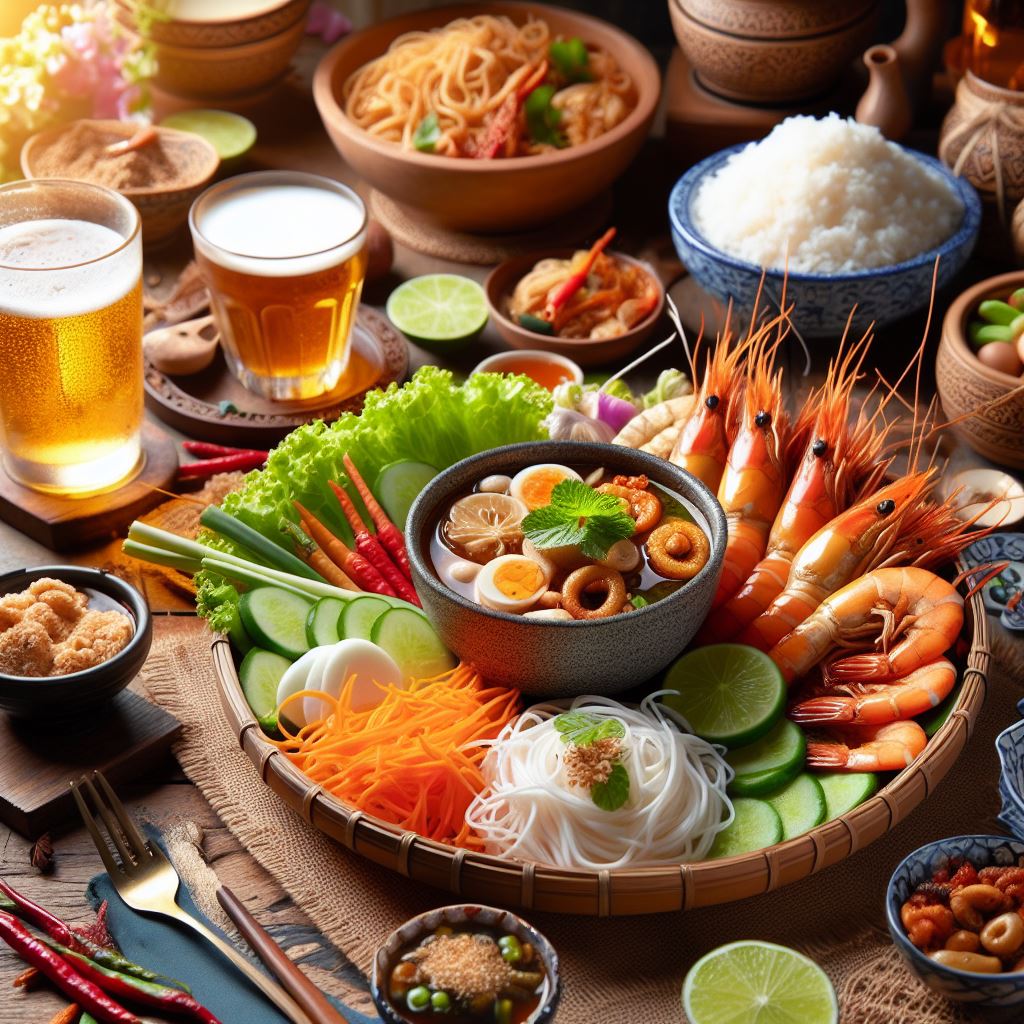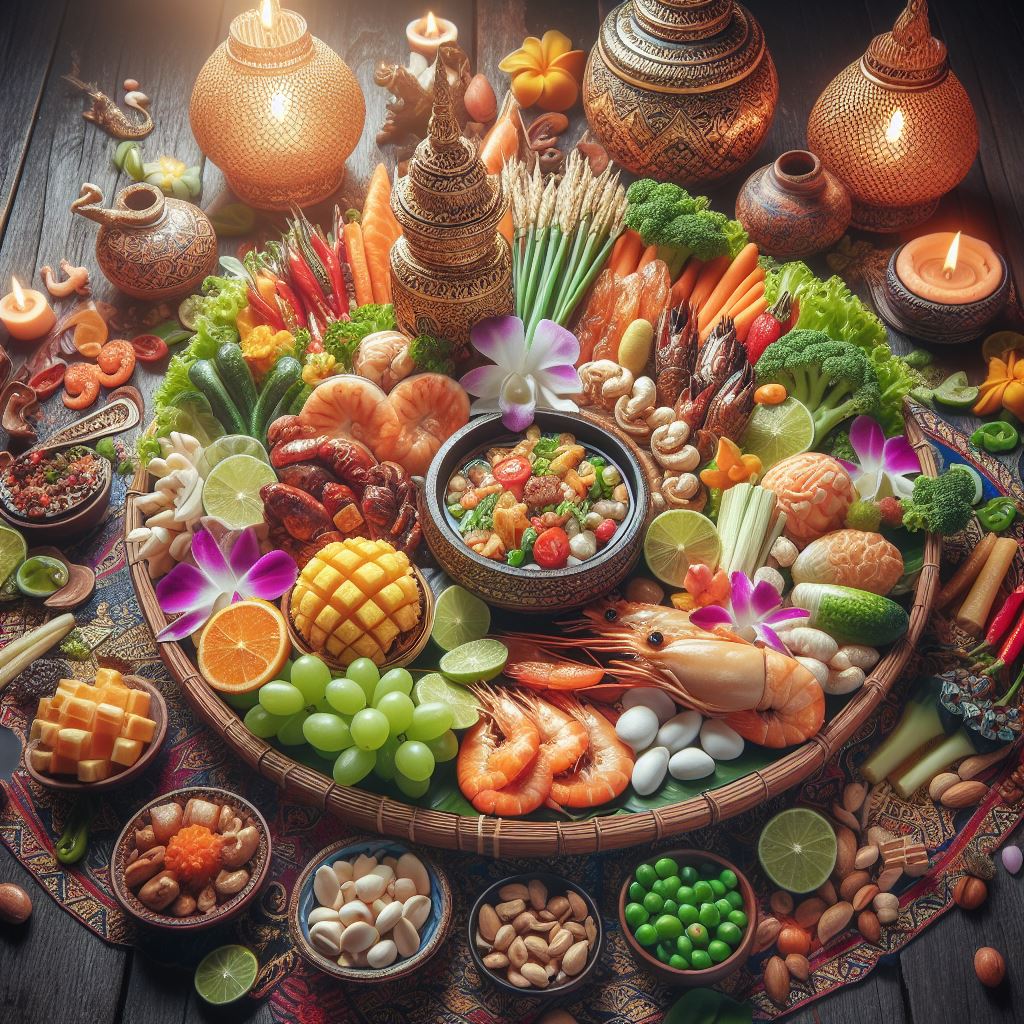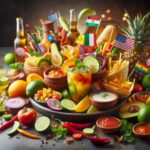Thai Delights offers a culinary adventure with iconic dishes like Pad Thai, a variety of curries, zesty stir-fries, aromatic Tom Yum Soup, and sweet Mango Sticky Rice. These traditional favorites capture the essence of Thailand’s rich gastronomy.
Explore the bold flavors and vibrant culture of Thailand through its food. Iconic Pad Thai provides an irresistible combination of sweet, sour, and savory wrapped in stir-fried noodles. Thai curries, ranging from mild green to fiery red, are a perfect blend of spices, coconut milk, and fresh ingredients.

The Culinary Essence Of Thailand
Central to Thai cuisine is the harmony of five fundamental flavors: sweet, sour, bitter, salty, and spicy. These tastes come to life in iconic dishes, perfectly exemplifying the essence of Thai cooking with ingredients like fish sauce, tamarind, chili, and palm sugar.
A Blend Of Flavors: Sweet, Sour, Bitter, Salty, And Spicy
- Sweet: Often derived from sugars like palm sugar, coconut sugar, or fruits.
- Sour: Comes from lime juice, tamarind, or green mangoes.
- Bitter: Integrate with herbs like bitter melon or raw banana leaves.
- Salty: Fish sauce and soy sauce are the main sources.
- Spicy: Fresh, pickled, or dried chilies heat up dishes.
The Importance Of Balance In Thai Dishes
In Thai cooking, balance is key. Not one flavor overshadows another. Chefs fine-tune each dish to reach a harmonious blend. Let’s take Pad Thai, a street food favorite. It offers a perfect balance with its sweet palm sugar, nutty peanuts, tart lime, and savory fish sauce mixed with earthy noodles.
Fundamental Ingredients In Thai Cooking
Exploring Thai Cuisine leads to a world bursting with flavors. Thai dishes, like Pad Thai and Tom Yum Soup, owe their rich tastes to unique ingredients. Understanding these ingredients is key to unlocking the secrets of Thai cooking. Let’s dive into the essentials that bring Thai delights to life.
Herbs And Spices: The Foundation Of Flavor
Elevate your taste buds with the aromatic wonders of Thai herbs and spices. They are crucial to creating authentic Thai dishes. Galangal, lemongrass, and kaffir lime leaves infuse meals with an unforgettable zing. Pungent and hot flavors come from garlic, chilies, and shallots. These staples, alongside cilantro and Thai basil, are non-negotiables for that Thai taste.
- Galangal: Infuses citrusy and piney notes.
- Lemongrass: Adds a fresh, lemony zest.
- Kaffir Lime Leaves: Imparts a unique, fragrant aroma.
- Garlic and Shallots: Provide a savory depth.
- Fresh Chilies: Offer heat tailored to your spice tolerance.
- Cilantro and Thai Basil: Fresh herbs that finish dishes with a burst of flavor.
Unique Proteins: Seafood, Meats, And Beyond
Thai dishes often feature an array of proteins, from tender meats to fresh seafood. Chicken and pork are popular, but Thai cuisine stands out with its use of duck and even insects. Coastal regions showcase an impressive variety of seafood. Common choices include shrimp, fish, and squid, adding texture and nourishment.
- Chicken: A go-to option for curries and stir-fries.
- Pork: Often ground for skewers or sliced for soups and salads.
- Duck: Delivers a richer flavor in sophisticated dishes.
- Insects: A crunchy delight in some local Thai snacks.
- Seafood: Fresh catch that brings the ocean’s bounty to the table.
Staple Elements: Rice, Noodles, And Vegetables
Can you picture Thai food without rice or noodles? Rice is the heart of many meals, both savory and sweet. Jasmine rice is fragrant and often accompanies curries. Sticky rice pairs with mango for a popular dessert. Noodles, like those in Pad Thai, come in different shapes and sizes. Veggies add crunch and color to keeping things balanced and healthy.
| Element | Type | Typical Dish |
|---|---|---|
| Rice | Jasmine, Sticky | Curries, Mango Sticky Rice |
| Noodles | Rice Noodles, Egg Noodles | Pad Thai, Soup Noodles |
| Vegetables | Bell Peppers, Bamboo Shoots, Eggplant | Stir-Fries, Curries |
Iconic Thai Dishes And Their Stories
Iconic Thai dishes tell stories of rich heritage and culinary adventure. Thailand’s cuisine reflects its culture, history, and spirit. Each bite takes you on a journey through the bustling streets of Bangkok to the lush, green countryside. Ready your taste buds for an exploration of Thai flavors and the tales behind these beloved dishes!
Pad Thai: Thailand’s Quintessential Stir-fry
Pad Thai, a vibrant mix of noodles, eggs, and fresh veggies, reigns as one of Thailand’s staple dishes. Its origins date back to World War II, created during a time of rice shortage. It turned into an emblem of Thai resourcefulness and creativity. This dish not only serves as a delicious meal but also symbolizes national pride.
Green Curry: The Spicy Heart Of Thai Cuisine
Green curry stands out with its vivid color and intense heat, coming from fresh green chilies. Originating from central Thailand, it’s a testament to the country’s love for complex flavors. Combined with coconut milk and fresh herbs, it offers a deliciously spicy and creamy experience of Thailand’s tropical abundance.
Tom Yum Goong: A Symphony Of Spices In A Soup Bowl
Tom Yum Goong brings a symphony of lemongrass, galangal, and kaffir lime leaves to the table. This hot and sour soup became famous for its medicinal herbs and breathtaking flavor. Each spoonful whispers stories of Thai fishermen who used fresh catch and local spices to create this aromatic delight.
Som Tam: The Fiery Pleasure Of Green Papaya Salad
Som Tam, a spicy green papaya salad, bursts with chili, lime, and fish sauce flavors. Born in northeast Thailand, it showcases the blend of four taste senses: sour, spicy, sweet, and salty. This dish captures the essence of the Thai community and is often enjoyed with friends and family over laughter and conversation.
Mango Sticky Rice: A Sweet Conclusion
The perfect end to any Thai meal is Mango Sticky Rice. Sweet and savory, its base is sticky rice cooked in coconut milk, crowned with ripe mango slices. It’s a seasonal treat, coinciding with the mango harvest, and brings a story of Thai festivities and joyous occasions to your dessert table.
Street Food: Experiencing Local Flavors
Set off on a culinary adventure with Thailand’s vibrant street food scene. From Pad Thai weaving its magic on a hot griddle to curries simmering in pots, flavors come alive by the roadside. Explore bustling markets where stir-fries sizzle and Tom Yum soup exudes its lemongrass scent. Save room for sweet mango sticky rice as your journey unfolds through Bangkok’s lanes, Chiang Mai’s alleys, and the electric buzz of night markets.
Bangkok’s Bustling Street Food Scene
Step into the heart of food paradise. Bangkok’s streets echo with the clatter of works and the chatter of locals. Stalls overflow with fresh ingredients. Every alley tells a story, and each dish reveals a secret.
- Succulent grilled meats leave you craving more.
- A bowl of noodle soup warms the soul.
- The zest of spicy papaya salad invigorates the senses.
- Sweet aromas from mangoes and sticky rice entice passersby.
Northern Delicacies: Chiang Mai’s Street Eats
Chiang Mai presents a symphony of flavors unique to northern Thailand. Street corners serve as gateways to culinary haven. Here, spice meets mild in a balanced blend.
- Witness the creation of Khao Soi, with its rich coconut curry.
- Discover the crunch of Sai Oua, a smoky herb-infused sausage.
- Savor sticky rice paired with zesty Som Tum.
The Night Markets: A Feast For The Senses
As night falls, markets come to life. Stalls glow under hanging lanterns. Music and laughter fuse with the sizzle of street eats. Feast your eyes and taste buds on an array of dishes.
| Dish | Description |
|---|---|
| Grilled seafood | Charred to perfection, with a hint of lime |
| Taralli | Deep-fried dough twists, a crunchy delight |
| Pad Thai | A timeless classic stir-fried to a perfect umami balance |
Thai Cuisine In The Modern World
Thai cuisine has conquered palates all over the globe with a blend of sweet, sour, salty, and spicy flavors. The journey of Thai food from local streets to every corner of the world highlights its versatility and wide appeal. Today, we explore how Thai delights integrate into modern dining trends, from classic Pad Thai to aromatic curries and vibrant stir-fries.
Thai Food Goes Global: From East To West
The spicy kick of Tom Yum Soup and the comfort of Pad Thai are now common in Western cities. Thai restaurants serve up authentic dishes far from their homeland. Mango Sticky Rice is the sweet finale of these global menus. The spread of Thai cuisine showcases the power food has to cross cultural boundaries.
- Multiple outlets in major cities
- Global supermarket aisles featuring Thai ingredients
- Cookbooks and cooking shows inspiring home chefs

Fusion Foods: The New Face Of Thai-inspired Dishes
Thai-infused recipes create a buzz among foodies. Chefs worldwide blend Thai flavors with local cuisines, crafting unique, mouth-watering creations. Take the zesty Thai curry pizza or spicy lemongrass tacos. These dishes show the creative partnership of tradition and innovation.
- Bold Thai spices meet Mexican staples.
- Italian classics infused with Thai herb magic.
- Stir-fry techniques enhance Western vegetables.
Healthy And Sustainable Eating: Thai Dishes For Well-being
Thai food offers more than just taste; it’s a ticket to healthy living. Dishes like stir-fried greens or papaya salad are packed with nutrients. Many Thai meals use fresh, locally sourced ingredients supporting sustainable practices.
| Dish | Key Ingredients | Health Benefits |
|---|---|---|
| Pad Thai | Rice noodles, peanuts, tofu | Energy and protein |
| Tom Yum Soup | Lemongrass, kaffir lime leaves, galangal | Immunity boost |
| Green Curry | Green chilies, coconut milk, basil | Anti-inflammatory |
Cooking Thai At Home
Imagine bringing the bursts of Thai flavors right into your own kitchen! Cooking Thai at home is not just about recreating exotic tastes. It’s an adventure that tingles all your senses. Fresh herbs, spicy chilis, and that magical umami balance all play a part in dishes like Pad Thai, green curry, or Tom Yum soup. And for dessert, the sweetness of mango sticky rice awaits. Let’s start by setting up your pantry and then dive into recipes and techniques that will turn you into a Thai cooking wizard!
Stocking Your Pantry With Thai Essentials
Begin with the basics. Essential Thai ingredients form the foundation of an authentic taste experience. For a well-stocked pantry, use this simple checklist:
- Fish sauce – The secret to that deep umami flavor.
- Tamarind paste – Adds a delightful tangy taste.
- Coconut milk – For creamy curries and desserts.
- Lemongrass, galangal, and kaffir lime leaves – The threesome that encapsulates Thai aroma.
- Chilies – Dial up the heat with Thai birds or red chilies.
- Palm sugar – Balances spice with its caramel sweetness.
- Thai jasmine rice – The perfect fluffy side for your Thai meals.
Simple Thai Recipes For Beginners
Ready to whisk up some Thai magic? Start with these easy recipes:
- Classic Pad Thai: Stir-fried noodles with a sweet and savory sauce.
- Thai Fried Rice: A quick meal with vegetables and eggs.
- Tom Yum Soup: A hot and sour soup with shrimp or tofu.
These dishes ensure a tasty introduction to Thai cooking. With minimal steps, enjoy big flavor outcomes.
Advanced Techniques For Authentic Flavors
Now, elevate your skills:
| Technique | Application |
|---|---|
| Making curry paste from scratch | Grind fresh herbs and spices for a vibrant base. |
| Fermenting shrimp paste | Develops depth in sauces and marinades. |
| Perfecting sticky rice | Learn the art of steaming for that ideal texture. |
Mastering these methods will impress any Thai food enthusiast.
Vegetarian And Vegan Variations Of Thai Classics
Thai cuisine is vegan-friendly. Substitutions are simple and satisfying:
- Use soy sauce instead of fish sauce.
- Mushroom broth as a stock alternative.
- Tofu or tempeh for protein-rich meat replacements.
- Agave syrup in place of honey.
With these swaps, you can enjoy vegetarian or vegan versions of all Thai classics without losing the essence of their flavors.
Conserving Traditional Thai Cuisine
Thai cuisine offers a tantalizing array of flavors, with dishes like Pad Thai, curries, stir-fries, Tom Yum Soup, and Mango Sticky Rice. These delights extend beyond mere sustenance; they embody Thailand’s rich cultural tapestry. Conserving traditional Thai cuisine is imperative. It involves honoring recipes passed down through generations. Understanding the history and ethos embedded in each dish is crucial.
Culinary Heritage And Preservation Efforts
The essence of Thai food lies in its heritage. Each ingredient, method of preparation, and presentation represents a story from the past. Conservation efforts are vital to maintaining this culinary legacy. Groups and individuals work tirelessly to ensure that traditional Thai dishes retain their authenticity and distinctive flavors.
- Documentation of ancient recipes
- Support for Indigenous ingredients
- Organizations advocating culinary heritage
The Role Of Street Vendors And Small Eateries
Street vendors and small eateries are the heart of Thai food culture. They serve up age-old recipes daily. Their contribution to preserving traditional Thai cuisine is immense, offering authentic tastes to locals and visitors alike. Many are family-owned, with recipes that tell their family history.
Authentic flavors
Family traditions
Homemade recipes
Cooking Schools And The Transmission Of Knowledge
Cooking schools play a pivotal role in safeguarding Thai cuisine. They offer classes that teach the intricacies of Thai cooking to enthusiasts from around the world. These schools are not just classrooms. They are keepers of culinary art, ensuring the transmission of knowledge to future generations.
- Hands-on cooking classes
- Use of traditional cooking utensils
- Focus on authentic Thai recipes
The Future Of Thai Cuisine
Thai cuisine has always captivated food lovers around the world. Classic dishes like Pad Thai, vibrant curries, zesty stir-fries, the iconic Tom Yum Soup, and sweet Mango Sticky Rice tell a tale of a rich culinary tradition. Yet, as the world palette evolves, Thai cuisine stands at a crossroads of innovation and preservation.
Embracing Change While Honoring Tradition
Thai food is known for its balance of sweet, sour, salty, and spicy flavors. Chefs in Thailand and beyond are exploring new avenues to retain authenticity while introducing contemporary twists. These experiments ensure Thai cuisine remains both exciting and familiar for future generations.
The Continued Evolution Of Thai Cooking
- Integration of modern techniques
- Use of sustainable, locally sourced ingredients
- Inspiration from global culinary trends
Thai chefs are pushing boundaries with inventive recipes. Yet, they stay rooted in tradition. This evolutionary journey is essential for any cuisine striving to stay relevant in an ever-changing culinary landscape.
Thai Cuisine’s Place In The World’s Culinary Tapestry
Thai food is a shining star in the global food scene. Its rich flavors and adaptable nature make it a favorite. Thai cuisine is set to thrill future palates while remaining a cherished heritage.

The Bottom Line
Embarking on a culinary journey through Thailand is truly an adventure for the senses. From the tang of Pad Thai to the rich warmth of curries, each dish offers a unique taste experience. Stir-fries bring out the fresh flavors of Thai cuisine, while Tom Yum soup provides a spicy zing.
And let’s not forget the sweet notes of mango sticky rice to wrap up a feast. Savor the delights of Thai cooking and let your palate explore the vibrant tapestry of flavors that this amazing cuisine has to offer.
Frequently Asked Questions For Thai Delights
What Are The Top 5 Foods In Thailand?
The top 5 foods in Thailand include Pad Thai, Som Tum (Papaya Salad), Green Curry (Gaeng Keow Wan), Tom Yum Goong (Spicy Shrimp Soup), and Massaman Curry.
What Thai Food Should I Try For The First Time?
For first-time Thai food tasters, try Pad Thai, a classic noodle dish. Sample Tom Yum Goong, a spicy shrimp soup, and savor the flavors of Green Curry with its aromatic blend of herbs and coconut milk. These dishes offer an authentic taste of Thailand’s culinary diversity.
What Do Thai People Eat Sticky Rice With?
Thai people traditionally eat sticky rice with grilled meats, spicy salads, and flavorful sauces or dips like nam prik or jaew. It’s also enjoyed with sweet mangoes as a dessert.
What Is Thailand’s Food Ranked In The World?
Thailand’s cuisine is globally celebrated, often ranking within the top 10 of the world’s best food lists. Renowned for its flavors, it embodies a blend of sweet, sour, spicy, and savory.







